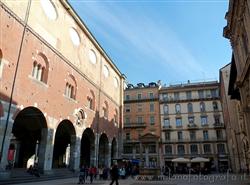|
Mercanti Square
|
|
|
Show an other treasure of art and history in Milan:
|
 Mostly represented styles: Gothic - Renaissance Mostly represented styles: Gothic - Renaissance
Piazza Mercanti is the true center of Milan, as it is easy to see looking at the map of the city. It was created from the middle of the thirteenth century (it is therefore older than the Milan Cathedral) with a rectangular plan, and it was originally greater than now. There were six openings toward it, corrisponding to the six parts in which the city was divided. The surrounding streets were named after the various activities carried out.
Until the second half of the nineteenth century it was connected to the Duomo Square through an archway that passed across residential buildings.
In fact, the first stretch of Via Mercanti is part of the square, so the Palazzo della Ragione (or New Broletto), the building whose lower floor is open on all sides is at the center of the square, and not on the one hand, as one could think.
The other main buildings are:
Palazzo della Ragione (or Broletto )
It was erected in 1233 on the will of the mayor Oldrado from Tresseno (or Dresano ) and was used for a long period , until 1776.
In 1773 - during the reign of Empress Maria Theresa of Austria it became the headquarters of the notary and was expanded through the addition of an additional plan, characterized by large oval windows in neoclassical style.
Loggia degli Osii
The Osii Loggia is located opposite the Palazzo della Ragione and was built in 1316 by order of Matteo Visconti. The building is equipped with front Gothic arcades.
Note the balcony, from which in the past edicts were read, and statues found in mullioned windows on the top floor and the band with the heraldic emblems of the districts (which took its name from the historic six-port ) of the city, the city itself and with the coats of arms of the Visconti.
Palatine schools
The building to the right of the Lodge Osii , was built to a design by Carlo Buzzi in 1644 after a fire had destroyed the pre-existing building. The style was based on that of the Palace of Giuriconsulti. In the middle of the facade of the building there is a niche with a statue of St. Augustine, who would teach in their schools palatine, executed by the sculptor Peter Lasagna. Around the square stands the marble statue of the poet Decimus Magnus Ausonius flanked by two white marble slabs.
House of Panigarola
The building is characterized by stubby pointed arches.
It was house of the Office of the Statutes which provided the recording and transcription of the ducal decrees.
The name comes from the fact that the office, hereditary privilege, was held by Panigarola.
Giuriconsulti Palace
Its construction began in 1562 in Renaissance style. The building was intended to house the seat of the Collegio dei Nobili Dottori ("College of the Noble Doctors"), institution which comprehended the administrative figures of the city: senators, judges, and captains of Justice. The noble history of the college ended in 1797, with the arrival of Napoleon's troops in Milan.
The well in the square, finally, dates back to the sixteenth century.
Sources : page on Wikipedia
Milan Province
If you are interested in a guided tour of this monument send an email!
Categories: Interesting details, villages of
Piazza Mercanti Milano |
Further pictures of the Mercanti Square in the section Photography |